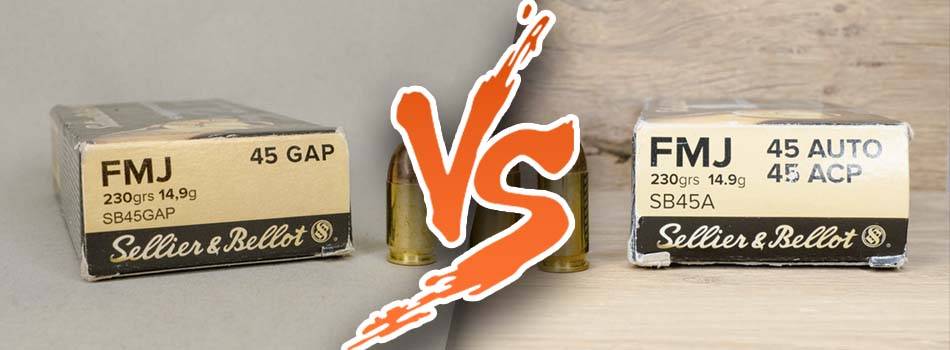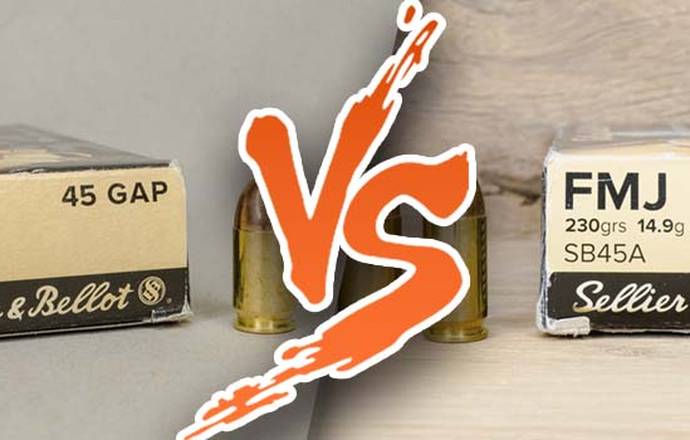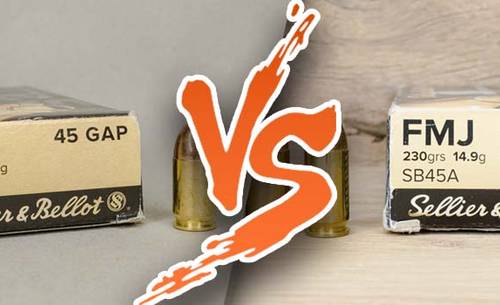


Table of Contents
If you're weighing the options between .45 GAP vs .45 ACP ammunition and unsure of which is the better fit for your needs, I'm here to guide you through the nuances of these two prevalent calibers.
For those new to gun ownership and seasoned enthusiasts alike, grasping the differences between the .45 GAP vs .45 ACP is essential prior to making any purchasing decisions.
INTRODUCING TWO BEAUTIES
The .45 GAP (Glock Automatic Pistol) boasts a shorter case than the .45 ACP, measuring 0.760 inches, yet it provides performance that rivals the well-regarded .45 ACP. Created to offer equivalent outcomes in a more condensed package, the .45 GAP is a contemporary challenger in the world of ammunition.
Conversely, the .45 ACP (Automatic Colt Pistol) continues to be a preferred choice for its established effectiveness and reliable stopping power, earning its place as a staple among gun owners for both its dependability and proficiency.
BREAKING DOWN THE DIFFERENCES
We’ll dissect the distinctions between these calibers, examining their ballistic characteristics, overall performance, and appropriateness for various applications.
Whether you're inclined towards the time-honored efficiency of the .45 ACP or the modern engineering of the .45 GAP, understanding their differences is key to making a well-informed choice that aligns with your individual requirements and preferences.
Let’s try to settle the ongoing debate between .45 GAP vs .45 ACP and see which would be the best choice for your needs.
HISTORICAL BACKGROUND AND EVOLUTION
The development and progression of ammunition types such as the .45 ACP and .45 GAP are deeply rooted in a history filled with technological progress and the evolving demands of firearms aficionados.
THE .45 ACP
Conceived in the early 1900s by the legendary John Browning, the .45 ACP has a rich history, initially designed to enhance the stopping power and reliability for military use.
Its official adoption by the U.S. Army in 1911 cemented its legacy in the annals of firearm history. The caliber's considerable popularity among civilian shooters can be attributed to its controllable recoil and efficacy in self-defense situations.
Firearms like the Colt M1911 and the Heckler & Koch USP Compact, chambered in .45 ACP, underscore its lasting popularity within the gun community.
THE .45 GAP
On the other end, Glock introduced the .45 GAP in 2003, aiming to address the .45 ACP's shortcomings in smaller-framed handguns.
The .45 GAP was engineered to deliver .45 caliber firepower within a shorter cartridge, allowing for compatibility with handguns designed around smaller grip sizes than those typically accommodating the .45 ACP.
Despite not achieving the widespread acceptance of the .45 ACP, the .45 GAP has carved out a niche amongst shooters who value its performance in more compact firearms.
The reception among the shooting community has been polarized, with some praising its innovative approach while others remain loyal to the traditional .45 ACP for their shooting requirements.
BALLISTICS AND PERFORMANCE ANALYSIS
Ballistics plays an integral role in gauging the efficacy of various types of ammunition. When evaluating the .45 GAP against the .45 ACP, it's pivotal to consider aspects such as muzzle velocity, energy output, stopping power, and recoil, which collectively determine their performance in different scenarios.
MUZZLE VELOCITY AND ENERGY
- The .45 GAP cartridge generally boasts a higher muzzle velocity compared to the .45 ACP, leading to a flatter trajectory and, in my experience, enhanced long-range precision.
- Conversely, the .45 ACP, albeit marginally slower, gives you more energy upon impact, potentially offering superior stopping power in situations requiring self-defense.
Intended use and the shooter's personal inclinations will factor a lot here.
STOPPING POWER AND RECOIL
If you’re new to firearms, the concept of stopping power is a fundamental one—it refers to a bullet's capability to incapacitate a target swiftly.
- The .45 ACP is renowned for its exceptional stopping power, attributed to its larger bullet diameter and heftier grain weight when compared to the .45 GAP.
- This increased efficacy, however, is accompanied by a higher perceived recoil, which may influence shooter comfort and accuracy negatively.
- The .45 GAP, with its shorter cartridge design, could present a marginally reduced recoil, potentially offering a more manageable experience for certain shooters.
When it comes to ballistics and performance, weighing the pros and cons of velocity, energy, stopping power, and recoil is essential to identify the caliber that best aligns with your needs, be it for self-defense or target practice.
Both the .45 GAP and .45 ACP possess distinct advantages and disadvantages, making them favored options among both firearm enthusiasts and novices.
AVAILABILITY AND COST CONSIDERATIONS
In the comparison between .45 GAP vs .45 ACP ammunition, availability and cost are critical for both gun owners and enthusiasts. Here, I’ll give you a quick look into the market dynamics and price variations for these two popular calibers.
MARKET PRESENCE AND DEMAND
The .45 ACP enjoys a solidified position within the firearms market, celebrated for its historical significance and widespread application across various handgun models, including the iconic 1911.
Introduced as a contemporary alternative designed to mimic the .45 ACP's ballistics in a compact cartridge suitable for Glock pistols, it has (unfortunately) faced challenges in achieving comparable market acceptance.
The .45 ACP's enduring reputation and its compatibility with a wide array of firearms contribute to its popularity. In contrast, the more limited selection of firearms chambered for the .45 GAP has restricted its broader adoption, with fewer manufacturers supporting this caliber.
WHAT THIS MEANS
This disparity in market presence means that firearms chambered in .45 ACP are more accessible, ranging from traditional 1911 models to modern striker-fired handguns, sustaining its popularity. The .45 GAP, despite its specific advantages, struggles to match the .45 ACP's demand and extensive market footprint due to its niche positioning and the reduced availability of compatible firearms.
PRICE COMPARISON
The impact of ammunition costs on gun ownership can be significant. For many of us in this economy, the price of rounds is going to play a pivotal role in decision-making.
The .45 ACP, thanks to its widespread popularity and demand, is readily available in a diverse array of options, from the basic FMJ (Full Metal Jacket) rounds to the more sophisticated self-defense hollow points.
This broad availability often leads to more competitive pricing, positioning the .45 ACP as a financially sensible choice for shooters who prioritize cost-efficiency without sacrificing performance.
BULK PURCHASES OF THE .45 GAP
Contrastingly, .45 GAP ammunition faces challenges related to its more limited market presence and a smaller selection of compatible firearms. This scarcity can result in fewer opportunities for bulk purchases and higher costs per round, potentially dissuading those with tighter budgets.
Despite the .45 GAP's commendable performance, its premium price tag could be a significant barrier for individuals seeking a more budget-friendly shooting option.
45 ACP VS 45 GAP - CONCLUSION
In drawing comparisons between the .45 GAP and .45 ACP calibers, it's clear that each has its unique set of advantages and limitations.
The .45 ACP, with its rich history and widespread availability, remains a top pick among gun enthusiasts for its reliability and extensive bullet variety. Meanwhile, the .45 GAP provides similar performance within a more compact cartridge, appealing to those desiring a smaller firearm without sacrificing firepower.
MATCH YOUR CALIBER WITH YOUR NEEDS
For those new to firearm ownership, it's advisable to consider your specific needs and preferences when deciding between the .45 GAP and .45 ACP. Engaging in further research and gaining firsthand experience with both calibers can aid in making a choice that best aligns with your shooting style, comfort level, and intended use.
In the end, the decision between the .45 GAP and .45 ACP will be influenced by personal preferences and priorities, underscoring the importance of informed selection based on individual requirements.
CRAFT HOLSTERS FOR THE BEST IN CARRY OPTIONS
As you navigate through the world of firearms and ammunition, remember the importance of matching your holster to your chosen firearm for optimal safety and convenience.
For a wide selection of high-quality holsters tailored to fit a variety of handgun models, including those chambered in .45 GAP and .45 ACP, consider exploring the offerings at Craft Holsters.
Our expertly crafted holsters provide the perfect blend of functionality, durability, and style, ensuring that your firearm is secure and accessible whenever you need it.
Check out how a tailor-made holster can make a difference when it counts.
DO YOU FANCY SOME MORE LIGHT READING? THEN CARRY ON WITH THESE ARTICLES
BEST HOLSTER FOR KIMBER MAKO R7: TOP CONCEALED CARRY PICKS
9MM VS 40: THE DUEL OF THE DECADES
CLIP VS MAGAZINE: BREAK FREE FROM THE NOOB
